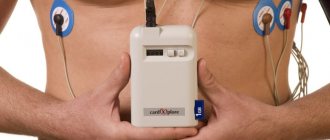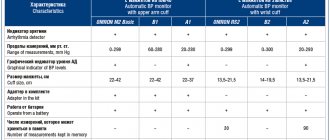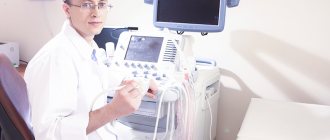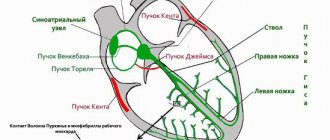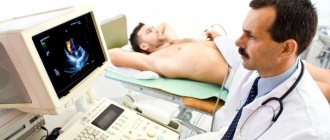24-hour blood pressure (BP) monitoring is a modern research method. Such diagnostics takes into account the daily rhythm of a person’s blood pressure in his or her usual environment. The data obtained together provide a complete picture of the influence of behavioral factors on blood pressure and reflect the dynamics of the influence of antihypertensive drugs in patients receiving therapy for high blood pressure.
How does the device work?
The essence of the procedure is to measure blood pressure at certain intervals. The measurement takes place regardless of the patient’s activities and his wishes - only the doctor sets the time interval. On average, it ranges from 12 to 30 minutes during the day and every hour at night.
During the entire study, the patient fills out a personal diary throughout the day, in which he enters any changes in his state of health and any symptoms that have arisen. By comparing ABPM indicators (24-hour blood pressure monitoring) and diary entries, the attending physician makes an accurate diagnosis. The diary describes the state of activity, rest, and medications the patient is taking. All this data allows us to evaluate pressure drops in a person who is resting or playing sports.
Content:
- How does the device work?
- When is diagnosis prescribed?
- Contraindications to the procedure
- Preparation for the procedure
- Preparation of documents
- Carrying out the procedure
- Preliminary instructions
- Rules for the patient
- What can you learn using ABPM?
- Decoding the results
Blood pressure and activity are two dependent indicators. The basis of the method is the comparison of data that takes into account the patient’s usual activity. In laboratory conditions, the obtained blood pressure readings are unreliable. The procedure lasts for 24-48 hours, depending on the reasons why ABPM was prescribed. A device is fixed on the human body that automatically measures blood pressure.
24-hour blood pressure monitoring at MediCity
ABPM is a paid medical service everywhere.
In our clinic, this diagnostic procedure is affordable. You can sign up for it and other studies (bicycle ergometry, ECG, ECHO-KG, HOLTER) at any time convenient for you. To do this, just call our contact center by phone: +7 (495) 604-12-12.
Cardiologists and other highly qualified medical specialists at MedicCity will do everything to preserve and strengthen your health!
When is diagnosis prescribed?
The most common reason for 24-hour blood pressure monitoring is to assess the effectiveness of antihypertensive therapy, especially in the case of combination treatment using several groups of antihypertensive drugs. Other reasons for prescribing ABPM include the diagnosis of early arterial hypertension, symptomatic arterial hypertension, patients with heart failure, with myocardial hypertrophy, in the presence of brain diseases, and suspected sleep apnea syndrome.
ABPM is used to examine patients suffering from various types of hypotension: constitutional and orthostatic.
ABPM allows you to determine the presence of so-called “office hypertension”, in the diagnosis of which it is necessary to promptly establish a work and rest schedule.
Features of the study in pregnant women
Daily monitoring of blood pressure in the later stages is also not contraindicated for pregnant women. Thus, in the presence of arterial hypertension, which was acquired even before the onset of pregnancy, the examination showed that upper and lower blood pressure decreases significantly during the night.
- Device for 24-hour blood pressure monitoring
This result is used to identify problems associated with high blood pressure in expectant mothers.
Contraindications to the procedure
The procedure for 24-hour blood pressure monitoring is a completely safe test and has no absolute contraindications. But there are relative contraindications, which include thrombophlebitis of the upper extremities, acute infectious disease (as a temporary contraindication), impaired motor activity due to the severity of some chronic diseases.
Psychological reasons (phobias and fears) are a contraindication for ABPM.
Carrying out the procedure
The patient should sit for a few minutes before the procedure. The key to correct diagnosis is the coordination of the actions of the doctor and the patient. The study is carried out:
- with installation of a cuff and tonometer;
- with the obligatory filling out of the diary by the patient;
- with removal of the device;
- with a comparison of the results obtained and the data entered by the patient.
Installing the device takes no more than 15 minutes. The appropriate position for installing the cuff is sitting. The cuff is placed on the right hand of a right-handed person and on the left hand of a left-handed person. It is important to consider which arm the patient has more active. The mark on the cuff should coincide with the most pulsating point on the arm (blood pressure will be measured using it). The point is located on the distal part of the shoulder and is easy to find. Using a special device, the cuff is fixed on the shoulder. A register and a mercury tonometer extend from this device.
Exemption from the army due to pressure
Clarifying the diagnosis
Hypertension is diagnosed based on differential diagnosis.
Therefore, my primary task is to organize a comprehensive examination for the conscript to check or clarify the diagnosis. I must ensure that my client sees a cardiologist, neurologist, endocrinologist, nephrologist and a number of other specialists. Only if each of them confirms that the young man has no other health problems that affect blood pressure, will we be able to continue working on hypertension. It also happens that during the examination, the client and I “find” the main diagnosis. For example, quite recently in my practice there was a case: during such an examination, a conscript was diagnosed with a hidden kidney disease. There is nothing wrong with this either: although the diagnosis of hypertension has not been confirmed, we will continue to work together. Now my task is for my client to receive a military ID for the main diagnosis. Moreover, the young man found out about his disease in time and will now be able to begin treatment so that the disease does not progress.
“If the disease is confirmed, the conscript will be able to be released from military service.
According to Article 43 of the Schedule of Diseases, in case of hypertension of the first stage, conscripts are assigned a fitness category of “B” and are issued a military ID. The same category should be set for the second stage of the disease. But with stage 3 hypertension, conscripts are released from the army with category “D” . Their conscription is prohibited not only in peacetime, but also in wartime.”
Collection of medical documents and recruitment events
I have been working with conscripts with hypertension for several years now and I know which military registration and enlistment office has what requirements for medical history. For example, some military commissariats require an extract confirming your stay in a hospital. Therefore, I need to make sure that all the requirements set by the military registration and enlistment office are met, and attach to the conscript’s personal file a package of documents that will be sufficient for the military medical commission.
For me, this is extremely important, because the absence of a single conclusion or certificate can result in a whole heap of unpleasant, although completely solvable, situations. However, such situations sometimes arise even with ideal preparation for a medical examination. For example, a doctor at the military registration and enlistment office can issue a referral for additional examination for a related disease - VSD. In such cases, I myself go to the military commissariat and demand that they issue a referral for hypertension.
It happens that doctors issue a referral for both hypertension and another disease. This risks the fact that my client may not have time to undergo diagnostics, and the decision on the fitness category will be postponed until next year. Then I do everything in my power to speed up the process.
Sometimes the decision of the draft commission disagrees with the Schedule of Diseases, and a conscript with stage 1 hypertension is assigned category “B” (they serve with it). Then I request a copy of the decision of the draft commission and submit an application to summon my client for a control medical examination. And already at the KMO I am trying to enlist in the reserves.
Situations can be very different, but I have already encountered them and know how to solve them.
Preliminary instructions
Blood pressure monitoring will proceed without complications if within two days the patient can meet several mandatory conditions: while measuring blood pressure, the patient must take a comfortable position and, if possible, extend his arm with the cuff. If these recommendations are not followed, you will not be able to obtain accurate results.
Excessive physical activity is not recommended on the day of ABPM. If recording of indicators occurs during work or movement, the patient must stop - this rule guarantees accurate results. If possible, during the period of blood pressure monitoring it is necessary to exclude stressful situations. You should not follow the measurements - such behavior will cause nervousness, which will affect the diagnostic results.
There is no need to worry about the operation of the device at night. As far as possible, the patient does his usual activities - goes to work, does household chores. You cannot limit yourself, otherwise you will not be able to get results in an environment close to the natural environment. If unpleasant symptoms occur, the patient makes notes in a diary indicating the time of day and the load that gave the body a negative reaction.
Features of Holter blood pressure monitoring
The technique assumes that the patient will strictly follow the rules and recommendations of the specialist. Otherwise, the readings will be incorrect, which will negatively affect the diagnosis and selection of drug treatment.
ABPM is a simple procedure. A “cuff” is placed on the patient’s arm with a device in the form of a small box attached to it using wires, to which the results of each measurement will be automatically transferred and recorded in memory.
During the entire period of wearing the cuff, a person is required to keep an observation diary in which he must record all the actions he performs during the monitoring period. It is necessary to write down with the exact time:
- time of falling asleep - waking up;
- any physical activity;
- taking medications;
- development of a stressful situation;
- meal.
The diary must indicate any changes in well-being, for example, the appearance of painful sensations.
The total duration of the study is 24 – 28 hours. The first two hours after installation of the cuff are excluded when constructing the graph as adaptation. Our specialist comes to the patient at the appointed time to remove the device. The specialist then extracts the received data to perform processing. The result is given to the patient. The interpretation is carried out by the attending cardiologist.
Rules for the patient
Correct measurements depend entirely on the patient's behavior. Keeping a diary is a prerequisite that guarantees diagnostic results. The daily routine is entered into the diary: sleep, exercise, psycho-emotional experiences, walks, clinical symptoms that arise during the day, taking medications. Detailed records will allow you to assess the condition of the body and the factors that worsen the patient’s well-being.
If any negative symptoms appear, the patient consults a doctor. Headaches (severe migraines), weakness or nausea are reasons to suspend ABPM. It is recommended to avoid crowded places and places with a lot of noise for two days - it will affect the recorder and prevent you from taking correct measurements. If the edge of the cuff moves, it needs to be corrected - the correct position of the cuff is 2 cm below the elbow. If the patient is concerned about the correct conduct of ABPM, the attending physician will be able to make an accurate diagnosis and prescribe effective treatment.
How is ABPM performed?
As a rule, a device for measuring daily pressure is installed in the morning or afternoon. Before installing the device, a person’s blood pressure is first measured using a conventional tonometer, and only after that the daily device is fixed.
A cuff is placed on the lower half of the shoulder and secured, as with a normal pressure measurement with a tonometer. Several test readings are taken. After this, the indicators are checked: if the values concur with a conventional tonometer, the patient is sent home exactly for 24 hours.
What can you learn using ABPM?
To diagnose the disease, the variability of blood pressure values during the day is used. The analysis of the results obtained is carried out on the basis of 4 indicators. Average blood pressure readings differ at night and during the day. During the daytime, normal blood pressure is 130 to 85 mm, and at night – 120 to 70 mm.
The second indicator is the recorded moments of maximum increase in blood pressure - the number of deviations from the norm indicates the complexity of the disease. The daily index is calculated, consisting of systolic and diastolic blood pressure. The last indicator that allows you to assess the patient’s health status is the magnitude of the morning increase in blood pressure.
Preparation
One of the advantages of daily blood pressure measurement is the lack of special training. However, doctors recommend adhering to the following recommendations:
- Be sure to tell your doctor about all medications you take on an ongoing basis. Some medications may need to be stopped several days before the test.
- 5-7 days before the study you must give up alcoholic beverages.
- On the day of the examination, it is recommended to wear loose, cotton clothing that does not restrict movement.
- On the eve of the test, try not to experience any serious physical activity. You should also avoid stressful situations.
